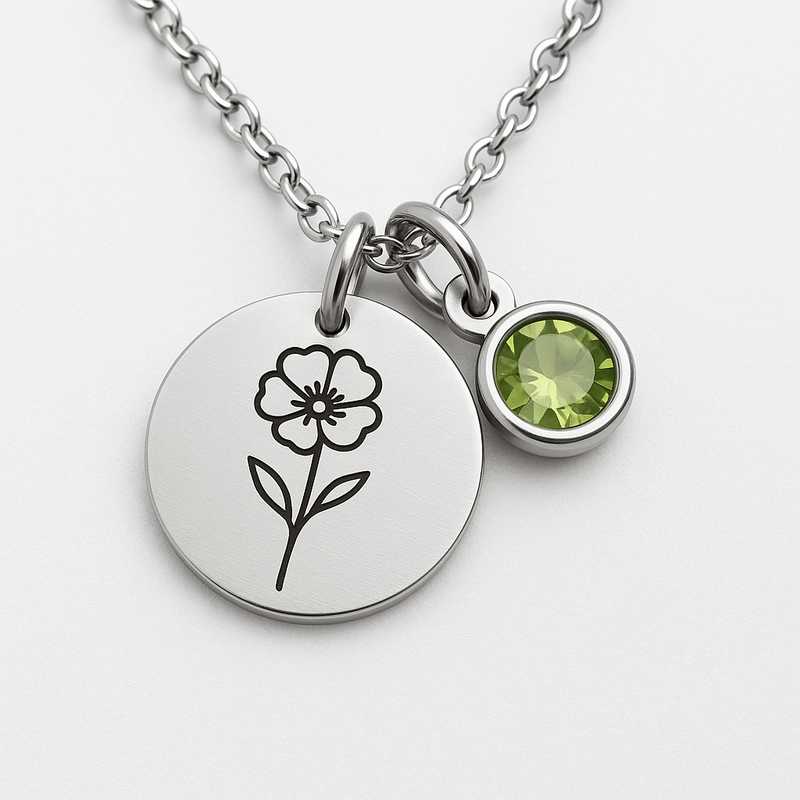Material Precision Meets Creative Design

Explore corrosion-resistant stainless steel and eco-conscious tech in OEM birthstone charm necklaces
In the competitive realm of stainless steel jewelry OEM/ODM production, mastering the intersection between durability and elegance is no longer optional—it’s essential. The custom birth month flower and birthstone charm necklace, while delicate in design, demands robust performance from the materials and manufacturing processes behind it. This is where advanced metallurgy, eco-conscious production, and precision fabrication technologies converge to deliver beauty that lasts.
From corrosion resistance in demanding environments to refined charm detailing using laser precision, today’s OEM producers must push the boundaries of what stainless steel can achieve. This page dives deep into the smart material choices—namely 304 vs. 316L stainless steel—along with cutting-edge manufacturing practices that are defining a new standard for B2B jewelry manufacturing in the era of sustainability and technical excellence.
Stainless Steel Selection: 304 vs. 316L in Jewelry Manufacturing
When it comes to stainless steel jewelry, two alloys dominate: 304 and 316L. While both are part of the austenitic stainless steel family and share characteristics like high strength and resistance to oxidation, they differ in corrosion performance and ideal use-cases.
304 Stainless Steel: Versatile and Cost-Efficient
- Composition: Contains 18-20% chromium and 8-10.5% nickel.
- Corrosion Resistance: Highly resistant to rust and oxidation under standard indoor and mildly humid environments.
- Application Scenarios: Ideal for general fashion jewelry, promotional accessories, and interior-wear charm pieces where salt exposure is minimal.
316L Stainless Steel: The Marine-Grade Upgrade
- Composition: Similar to 304 but with 2-3% molybdenum added, significantly enhancing chloride resistance.
- Corrosion Resistance: Superior performance in high-moisture, saline, or chemically active environments. Hypoallergenic properties are another advantage.
- Application Scenarios: Perfect for high-end or heirloom-quality charm necklaces, jewelry designed for everyday wear, or regional markets with coastal climates.
OEM Case Example: A premium wellness brand based in Bali selected 316L for its aromatherapy birthstone pendants to ensure resistance to ocean air, sweat, and essential oil exposure—boosting product longevity and brand reliability.
Precision Cutting & Forming: Laser and Hydraulic Technologies
Modern charm necklace production hinges on how well form follows function. High-definition laser cutting and advanced hydraulic stamping are revolutionizing the finesse achievable in micro-scale birth month flower motifs and bezel stone settings.
Laser Cutting: Ultra-Fine Customization
- Tolerance: Achieves sub-0.05 mm precision—ideal for intricate flower petal etchings and custom symbol layouts.
- Efficiency: Fast-cutting speeds reduce production lead times, supporting quick market turnarounds for seasonal OEM drops.
- Flexibility: Works seamlessly on both 304 and 316L, enabling brands to diversify material offerings without altering design files.
Hydraulic Forming: Structural Elegance
- Depth Control: Used for three-dimensional relief effects on birth month flower motifs, providing tactile detail and premium feel.
- Tool Longevity: Custom dies crafted for 316L require higher tonnage but deliver longer lifecycle with minimal maintenance.
Real-World OEM Insight: A US-based boutique jeweler implemented hydraulic embossing for multi-tiered lotus flower charms symbolizing May. The raised design allowed for deeper gemstone seating and tactile visual appeal, improving perceived value by 30% based on post-sale customer reviews.
Corrosion Pattern Testing and Longevity Assurance
Manufacturing birthstone charm necklaces isn’t just about initial beauty—it’s about lasting elegance. Corrosion pattern analysis helps OEM manufacturers select the right steel grade and finishing process for different use environments.
Testing Protocols in OEM Labs
- Salt Spray Testing (ASTM B117): Simulates years of environmental exposure within days. 316L typically withstands up to 2000+ hours without pitting.
- Artificial Sweat Immersion: Mimics skin interaction for hypoallergenic assurance and colorfastness over prolonged contact.
- Acidic Environment Soaking: Used for charm necklaces likely to come in contact with perfumes, skincare products, or coastal elements.
Surface Treatment Considerations
- Passivation: Enhances oxide layer formation, crucial for both 304 and 316L corrosion resistance.
- Electropolishing: Removes micro-pits where corrosion could initiate—ideal for high-end necklace chains and charm edges.
Case Study: A Canadian eco-brand added a corrosion pattern analysis stage to its production QA cycle, reducing product returns due to rusting by 42% within two quarters.
Eco-Friendly Manufacturing: Sustainable Jewelry with No Compromise
Sustainability is more than a buzzword—it’s a procurement priority. Forward-thinking OEMs are integrating environmentally responsible practices into every stage of production without compromising on quality.
Green Electroplating
- Trivalent Chromium vs. Hexavalent: Trivalent formulas drastically reduce toxic discharge and worker hazard levels.
- Wastewater Recycling: Closed-loop rinsing systems capture and treat electroplating effluents for reuse, cutting water use by up to 80% per batch.
Material Reclamation and Waste Sorting
- Scrap Recovery: Both 304 and 316L offcuts are collected, re-melted, and re-integrated into new coil stock—preserving material circularity.
- Polishing Dust Collection: Fine dust from finishing stations is vacuum-sorted to reclaim valuable steel and reduce airborne contaminants.
Low-Energy Fabrication Practices
- LED-Powered Workstations: Improve visibility while cutting operational energy use by up to 40%.
- Induction Heating for Annealing: Provides targeted heat zones, minimizing power waste and heat bleed-off into production environments.
OEM Highlight: A German contract manufacturer earned Tier 1 supplier status with a major European retail chain by integrating solar-assisted laser systems and solvent-free buffing compounds across all birthstone necklace lines.
Conclusion: Future-Proofing with Smart Materials and Clean Tech
Custom birth month flower and birthstone charm necklaces may evoke personal moments—but behind that sentiment lies engineering finesse. Choosing the right stainless steel alloy, applying targeted manufacturing technologies, and adopting green production standards all contribute to final products that meet both aesthetic and performance goals.
For B2B clients seeking a reliable OEM/ODM partner, these technical details are not just impressive—they’re decisive. By leveraging 316L for high-end durability, using precision tooling to enhance branding value, and adhering to environmental responsibility, you ensure that each necklace tells a story of both heritage and innovation.
Ready to elevate your next jewelry line? Let’s collaborate on manufacturing excellence, from concept to corrosion-proof charm. Contact our OEM team to start crafting with confidence.
